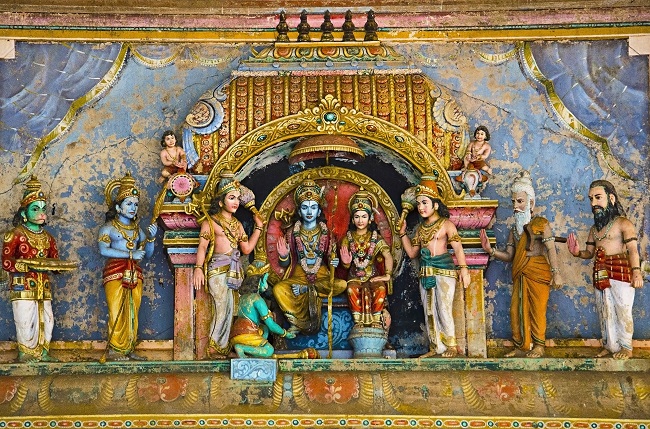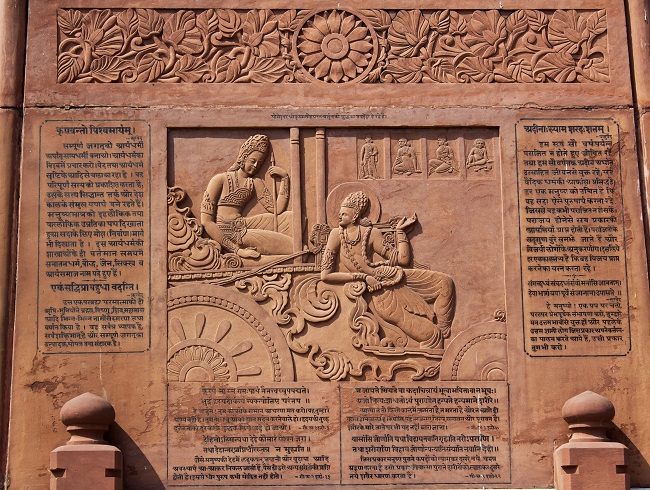Mar 30, 2025
Mar 30, 2025
Epics-3
Ramayana and Mahabharata
The ancient Indian epics, Ramayana and Mahabharata, hold significant cultural and religious importance in Hindu mythology. These monumental works have shaped the spiritual and moral fabric of Indian society for centuries. The key aspects of both these epics are that they highlight narratives of good and evil, symbolize the objectives of the human lives, and leave their profound, intense and passionate impact on Indian philosophy and literature. Both these epics have been composed in Anushtubh Chhand (Anushtubh Meter), consisting of 32 syllables arranged in four lines of eight syllables each.
The Ramayana: A Timeless Tale of Virtue, Love, and Honor
The Ramayana, one of the greatest epics of all time, stands as a testament to the rich cultural heritage and profound wisdom of ancient India. Composed by the sage Valmiki, this majestic epic narrates the extraordinary journey of Sri Rama, the seventh avatar of Bhagwan Vishnu, and showcases the triumph of good over evil, the importance of dharma (righteousness), and the enduring power of love.

At its core, the Ramayana portrays the life of Sri Rama, his devoted wife Sita, and his loyal brother Lakshmana. The epic takes us through their trials and tribulations, culminating in the epic battle against the demon king Ravana. Sri Rama's unwavering commitment to his duty, his unwavering loyalty to his subjects, and his embodiment of righteousness make him an ideal figure, revered as the epitome of virtue.
The Ramayana is rich in symbolism and moral lessons. Through its characters and their actions, it imparts valuable teachings on morality, loyalty, honor, and the consequences of one's choices. Sri Rama's unwavering adherence to dharma, even in the face of adversity, serves as a guiding principle for humanity. Sita, the epitome of loyalty and devotion, represents the purity of love and unwavering faith. The various other characters, such as Hanuman, the monkey god, and Jatayu, the loyal bird, exemplify traits like courage, selflessness, and sacrifice.
The epic is also replete with verses that capture the essence of its teachings. For example, the verse "Siyavar Ramachandra Ki Jai!" reverberates as a proclamation of victory to Sri Rama, acknowledging his divine presence and the embodiment of virtue. The verse "Dheeraj Dharam Mitrata Satya, Saundarya Subhasita Saadhu" extols the virtues of patience, righteousness, friendship, truth, beauty, and virtuous words. These verses evoke a sense of rhythm and beauty that enhances the poetic appeal of the epic.
Moreover, the Ramayana transcends its literary significance and has become an integral part of Indian culture and religious traditions. Its retelling and recitation during festivals, such as Diwali, symbolize the victory of light over darkness. The epic has been adapted into various art forms, including dance, music, and theater, captivating audiences across generations.
The Ramayana's enduring relevance lies in its ability to connect with the deepest aspects of human nature. It explores the intricacies of relationships, the complexities of moral dilemmas, and the eternal struggle between good and evil. It teaches us that righteousness, love, and honor are forces that can overcome any obstacle. The Ramayana serves as a moral compass, inspiring individuals to lead virtuous lives, uphold their responsibilities, and foster harmony within society.
Ramayana stands as a timeless epic, resonating with readers and listeners for centuries. Its profound teachings, compelling narrative, and iconic characters continue to captivate hearts and minds. Through the triumphs and trials of Sri Rama and his companions, the Ramayana imparts invaluable lessons on righteousness, love, and the indomitable power of good. Thus it remains an invaluable treasure, not only for the masses but for an individual also showing the right direction towards love and virtues.
Some Verses from the Ramayana are:
![]()
Ramo vigrahavan dharmah satyasandhasca vakpatih.
(Sri Rama is the embodiment of righteousness, the epitome of truthfulness, and the master of eloquence.)
![]()
Dharmae ca arthe ca kame ca mokse ca bharatarsabha.
(O best of the Bharata dynasty, righteousness, wealth, desire, and liberation are the four goals of human life.)
![]()
Manojavam marutatulyavegam jitendriyam buddhimatam varistham.
(Sri Hanuman, who is as swift as the mind and as powerful as the wind, with controlled senses and superior intellect.)
These verses showcase the profound teachings and character descriptions found in the Ramayana, reflecting the spiritual and philosophical essence of the epic.
The Mahabharata: A Saga of Duty, Destiny, and Spiritual Enlightenment
The Mahabharata, an epic of unparalleled magnitude, captures the essence of ancient Indian wisdom and spirituality. Composed by the sage Vyasa, this extraordinary epic narrates the epic Kurukshetra war and the intricate tales of the Kuru dynasty. At its core, the Mahabharata delves deep into the complexities of human relationships, moral dilemmas, and the eternal battle between righteousness and evil.
The Mahabharata unfolds the epic story of two sets of cousins, the Pandavas and the Kauravas, and their struggle for power and control over the kingdom of Hastinapura. The narrative encompasses various subplots, intricate character dynamics, and profound philosophical discourses. The epic culminates in the great war at Kurukshetra, where the Pandavas, led by the righteous prince Arjuna, face their own relatives, the Kauravas, in a battle that tests their strength, integrity, and resolve.

Central to the Mahabharata is the Bhagavad Gita, a philosophical dialogue between Sri Krishna, the charioteer, and Arjuna, on the battlefield of Kurukshetra. The Gita expounds on crucial spiritual concepts such as dharma, karma, and the path to self-realization. It imparts profound teachings on duty, devotion, and the importance of acting selflessly without attachment to the results of one's actions.
The Mahabharata is not merely a war epic; it delves into the depths of human emotions, virtues, and vices. Each character in the epic represents a distinct aspect of human nature, and their choices and actions reflect the complexities of life. Yudhishthira personifies righteousness and upholds his principles, while Arjuna symbolizes duty and moral dilemmas. Draupadi exemplifies strength, resilience, and the power of womanhood.
Embedded within the Mahabharata are verses that encapsulate its timeless wisdom. For instance, the verse "Yada Yada Hi Dharmasya Glanirbhavati Bharata, Abhyutthanam Adharmasya Tadatmanam Srijamyaham" declares that whenever righteousness declines and unrighteousness prevails, the divine manifests to restore balance. This verse adds a poetic touch to the epic's profound teachings.
Furthermore, the Mahabharata transcends its literary significance and has influenced numerous aspects of Indian culture and society. Its themes and teachings have inspired art, literature, dance, theater, and various forms of storytelling. The epic's retelling during festivals and cultural events symbolizes the eternal battle between good and evil, while its profound philosophy continues to guide individuals in their quest for self-realization.
The enduring significance of the Mahabharata lies in its ability to resonate with universal human experiences. It explores themes of power, greed, love, loyalty, and the consequences of one's choices. The epic teaches us that duty and righteousness must prevail over personal ambitions and desires. It imparts valuable lessons on the complexities of human relationships, the transient nature of life, and the importance of spiritual enlightenment.
Mahabharata stands as a monumental epic, unrivaled in its depth, scope, and philosophical insights. It weaves together a tapestry of stories, teachings, and profound wisdom that continue to captivate hearts and minds across generations. Through its intricate narrative and timeless verses, the Mahabharata offers profound lessons on duty, destiny, and the path to spiritual enlightenment. It serves as a guiding light, encouraging individuals to navigate the complexities of life with wisdom.
Some Verses from the Mahabharata:
![]()
"Yada Yada Hi Dharmasya Glanirbhavati Bharata, Abhyutthanam Adharmasya Tadatmanam Srijamyaham"
("Whenever there is a decline in righteousness and an increase in unrighteousness, O Arjuna, then I manifest Myself.").
![]()
"Karmanye Vadhikaraste Ma Phaleshu Kadachana, Ma Karma Phala Hetur Bhur Ma Te Sango 'stvakarmani"
("You have the right to perform your prescribed duty, but you are not entitled to the fruits of your actions. Never consider yourself the cause of the results of your activities, and never be attached to not doing your duty.")
![]()
"Vasudhaiva Kutumbakam"
("The whole world is one family.")
The Ramayana and Mahabharata are timeless epics that offer invaluable insights into the human condition, moral dilemmas, and the eternal struggle between good and evil. These epics continue to inspire and guide millions of people, not just in India but across the world. With their profound teachings, rich narratives, and deep philosophical wisdom, the Ramayana and Mahabharata remain cherished treasures of literature, spirituality, and cultural heritage.
10-Jun-2023
More by : Dr. Satish Bendigiri